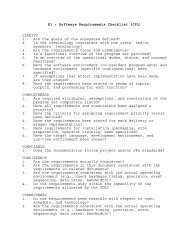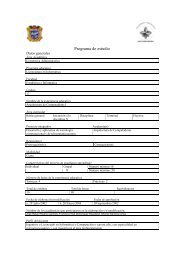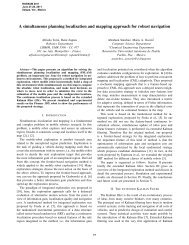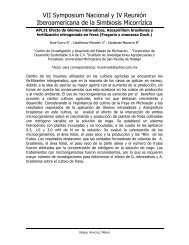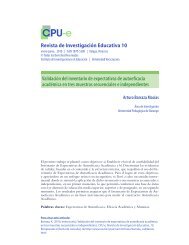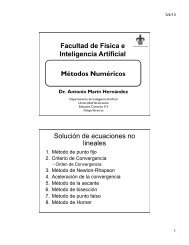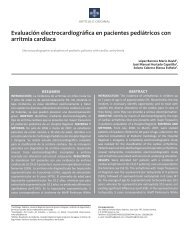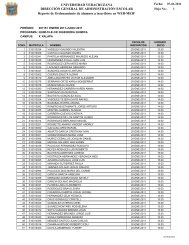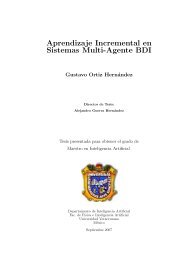Understanding the Software Options
Understanding the Software Options
Understanding the Software Options
Create successful ePaper yourself
Turn your PDF publications into a flip-book with our unique Google optimized e-Paper software.
TABLE 3. PURCHASE COST (C PCS) OF HEAT EXCHANGERS<br />
DFP ESTIMATE FOR ALL SHELL-AND-TUBE HEAT EXCHANGERS IS FOR U-TUBE TYPE; CS=CARBON STEEL; SS=STAINLESS STEEL<br />
Heat exchanger – shell and tube (Floating-head<br />
type)<br />
riving installed costs from purchase<br />
costs. For each piece of equipment,<br />
Guthrie provided factors to estimate<br />
<strong>the</strong> direct costs of field materials, such<br />
as piping, concrete, steel, instruments,<br />
controllers, electrical hardware, insulation<br />
and paint, as well as <strong>the</strong> direct<br />
costs of field labor used for <strong>the</strong>ir installation.<br />
These factors include material<br />
erection and equipment setting,<br />
as well as <strong>the</strong> indirect costs involved<br />
in installation, such as insurance,<br />
construction overhead and contractor<br />
engineering expense. The bare module<br />
cost (CBM) for a given piece of equipment<br />
i is thus defined as:<br />
CBM, i = CDE,i + CIDE,i =<br />
[Co P + CM + CL + CFIT + CO + CE] i (1)<br />
where CBM,i, CDE,i, CIDE,i and Co P are,<br />
respectively, bare module cost, direct<br />
cost, indirect cost and purchase cost of<br />
equipment i in base conditions (that is,<br />
CapCost DFP CCEP EconExpert<br />
Aspen-<br />
PEA<br />
Area, m 2<br />
Material CPCS ∆% ∆% ∆% ∆%<br />
CS4-E-102 4.62 CS/CS 28,750* –3%* –28%* –75%* –37%<br />
CS2-E-104 18.2 CS/CS 26,680 10% –21% –66% 50%<br />
CS3-E-101/<br />
102/103/104<br />
26.4 CS/CS 26,680 11% –18% –59% –22%<br />
CS4-E-103 28.2 CS/CS 26,795 12% –17% –58% –24%<br />
CS5-E-106 76.7 CS/CS 33,120 10% –14% –43% –6%<br />
CS5-E-107 127 CS/CS 40,940 8% –15% –38% –3%<br />
CS1-E-103/104 150 CS/CS 44,620 8% –16% –37% –3%<br />
CS4-E-101 405 CS/CS 87,055 11% –26% 32% –3%<br />
CS5-E-101 541 CS/CS 111,320 13% –16% –39% –7%<br />
CS5-E-109 680 CS/CS 138,000 14% –34% –42% 11%<br />
CS1-E-102 740 CS/CS 149,500 14% –34% –43% –25%<br />
CS5-E-108 902 CS/CS 181,700 15% –38% –35% 0%<br />
CS5-E-104 2130 CS/CS 430,100 9% –40% –42% -4%<br />
CS5-E-105 2900 CS/CS 587,650 19% –39% –43% –2%<br />
CS6-E-106 11.7 SS/SS 27,945 0% –26% –73% –31%<br />
CS6-E-101 14.6 SS/SS 27,140 5% –23% –69% –29%<br />
CS4-E-106 41 SS/SS 28,060 12% –15% –52% –17%<br />
CS6-E-102 61.6 SS/SS 30,820 11% –1% –46% –13%<br />
CS6-E-105 131 SS/SS 41,515 9% –4% –38% –4%<br />
CS6-E-107 192 SS/SS 51,290 8% –7% –36% –1%<br />
CS4-E-105 269 SS/SS 63,940 9% –21% –36% 3%<br />
CS5-E-102 456 SS/SS 96,025 12% –28% –38% –5%<br />
CS6-E-104 1090 SS/SS 224,250 4% –45% –40% –8%<br />
CS6-E-103 1760 SS/SS 355,350 31% –28% –45% 12%<br />
CS5-E-103 2010 SS/SS 405,950 15% –27% –41% –4%<br />
Heat exchanger – shell and tube (Fixed-head type)<br />
CS2-E-101 14.3 CS/CS 22,540 28% –52% –72% 49%<br />
CS1-E-101 20 CS/CS 26,565 9% –19% –64% –22%<br />
CS7-E-102 100 CS/SS 34,155 20% –36% –32% –15%<br />
CS7-E-103 240 CS/SS 48,990 34% –29% –16% –3%<br />
Heat exchanger – kettle reboiler<br />
CS2-E-102 85.3 CS/CS 120,750 –58% –67% –73% 67%<br />
CS4-E-104 37.3 SS/SS 59,340 –36% –47% –78% –61%<br />
Heat exchanger – double pipe<br />
CS2-E-103 5.41 CS 4,796 –35% –42% 26% 21%<br />
Heat exchanger – plate<br />
CS7-E-101 57 SS 95,450 –88% n/a +<br />
–80% –41%<br />
*cost of minimum size as size is less than <strong>the</strong> minimum size<br />
+<br />
not available in this program and so taken from ano<strong>the</strong>r program<br />
carbon steel material and atmospheric<br />
pressure). CM is <strong>the</strong> cost of field materials<br />
required for installation, CL is <strong>the</strong><br />
cost of labor to install equipment and<br />
materials, CFIT is <strong>the</strong> cost of freight, insurance<br />
and taxes, CO is <strong>the</strong> cost of construction<br />
overhead and CE is <strong>the</strong> cost<br />
of contractor engineering expenses. For<br />
<strong>the</strong> whole plant, Ulrich and Vasudevan<br />
[4] propose to find <strong>the</strong> total module cost<br />
(CTM) by multiplying CBM,i for all equipment<br />
types by <strong>the</strong> factor 1.18 to account<br />
for contingency and contractor fee.<br />
CTM = ∑ (CBM,i + CCont,i + CFee,i) =<br />
1.18 ∑ CBM,i (2)<br />
where CCont,i is contingency fee and<br />
CFee,i is <strong>the</strong> contractor fee.<br />
Computer programs<br />
The five progams used in this study are<br />
CapCost, DFP, CCEP, EconExpert and<br />
AspenPEA. Most programs use a para-<br />
metric-cost model for <strong>the</strong> cost estimates,<br />
which is useful in early conceptual estimates<br />
[5]. The cost equation constants<br />
used in <strong>the</strong>se programs are obtained<br />
from vendor quotes or from past literature<br />
data. As discussed by Woods<br />
[6] and Walas [7], when cost data are<br />
assembled from vendor quotes, <strong>the</strong>y exhibit<br />
scatter due to different qualities<br />
of equipment design, fabrication, market<br />
conditions, vendor profit and o<strong>the</strong>r<br />
considerations. Hence, <strong>the</strong> accuracy of<br />
published equipment-cost data may be<br />
no better than ±25%, and <strong>the</strong>refore <strong>the</strong><br />
estimating method based on <strong>the</strong>se data<br />
can only be used for study or preliminary<br />
estimates.<br />
CapCost is available with <strong>the</strong> process<br />
design book of Turton and coauthors<br />
[1]. It is based on <strong>the</strong> module costing<br />
method, written in Visual Basic, and<br />
can be used for estimating preliminary<br />
process cost. Bare module cost (CBM) is<br />
defined as <strong>the</strong> sum of <strong>the</strong> direct and<br />
indirect expenses for purchasing and<br />
installing equipment; <strong>the</strong> total module<br />
cost (CTM) is defined as <strong>the</strong> sum of <strong>the</strong><br />
bare module cost, contingency and fee;<br />
and <strong>the</strong> grassroots plant cost (CGR) is<br />
defined as <strong>the</strong> sum of <strong>the</strong> total module<br />
cost and <strong>the</strong> auxiliary facilities costs.<br />
To estimate <strong>the</strong> bare module cost and<br />
purchase cost of equipment, Turton<br />
and colleagues proposed <strong>the</strong> following:<br />
CBM = Co P × FBM = Co P (B1 + B2FMFP) (3)<br />
log Co P = K1 + K2log(S) + K3[log(S)] 2<br />
(4)<br />
where S represents a parameter for <strong>the</strong><br />
equipment size or capacity. Values for<br />
<strong>the</strong> constants B1 and B2, equipmentspecific<br />
constants K1, K2 and K3, as well<br />
as correlations and plots for F BM, F M, F P<br />
and C o<br />
P of different equipment can be<br />
found in <strong>the</strong> appendices in Ref. 1. These<br />
data are based on surveys of equipment<br />
vendors between May and September<br />
2001. The Chemical Engineering Plant<br />
Cost Index (CEPCI; see p. 56 and www.<br />
che.com/pci for current value) value of<br />
397 for this period can be used for escalating<br />
cost to a different time.<br />
Detailed Factorial Program (DFP)<br />
is based on <strong>the</strong> detailed factorial estimates<br />
method described in Ref. 2. For<br />
this program, <strong>the</strong> purchase cost, C o P ,<br />
of <strong>the</strong> major equipment items is esti-<br />
CHEMICAL ENGINEERING WWW.CHE.COM AUGUST 2011 23



